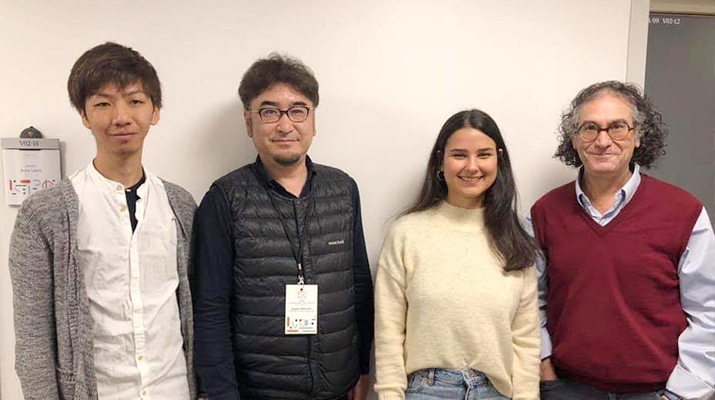
ここからコンテンツです。

Pupillary Response to Glare Illusions of Different Colors
A blue glare illusion was perceived as brightest and caused larger pupil constriction By Yuta Suzuki
The Department of Computer Science and Engineering at Toyohashi University of Technology formed a research team with the University of Oslo to measure the size of subjects’ pupils when viewing a brightness illusion (glare illusion). The pupil expands in dark environments and contracts in bright environments in order to control the amount of light that enters the eye. Pupil contraction is also known to occur when people feel that a viewed object is brighter, even though this may not be the case. This study involved showing glare illusions to subjects in a variety of different colors, and concluded that a blue glare illusion was perceived to be the brightest among all the colors and that subjects’ pupils constricted significantly in relation to this perception. The results of this study were published in the Dutch journal, Acta Psychologica on July 6.
The research team hypothesized that the blue glare illusion would be perceived as the brightest because the color blue is most associated with the sky and sunlight typically appears to have a gradient of luminance. In other words, the team surmised that the human visual system often relies on ecologically-based predictions to interpret visual input. The results of this study show that the blue glare illusion was evaluated to be brighter than any other color and that viewing this illusion resulted in significant pupil contraction. This effect is thought to be unique to glare illusions, as it was not observed for visual stimuli without any illusory glare effects.

Lead author and Ph.D. course student, Yuta Suzuki explains "The pupillary light reflex, in which the pupil constricts and dilates, follows a very concise route in neural processing. The same goes for the pupil responses we saw when subjects viewed the blue glare illusion in this study – the difference of larger pupil constriction among colors occurred with the pupillary light reflex. This may indicate that we have evolved to develop a faster pupillary reaction for illusions in specific colors. We also saw a correlation between pupil contraction and individual brightness perception. We hope to be able to use the pupillary light reflex as a simple tool for evaluating individual differences in brightness perception."
Assistant Professor Tetsuto Minami, who lead the research team, says that "Subjective brightness perception is an individual phenomenon that cannot be verified by others. That is, we could only rely on peoples' own reported brightness perception. In this study, we saw a correlation between brightness perception and pupil contraction, and this is a new development that can be used as an index for evaluating objective brightness perception."
Professor Shigeki Nakauchi, the Project Leader, mentions that "The pupillary light reflex has drawn attention as a way to investigate a person's mental state through non-contact measurement. Work involving the pupillary light reflex will create innovative, fundamental technologies that can achieve rapid progress in communication between humans as well as between humans and robots."
This work was supported by JSPS KAKENHI Grant Numbers JP17H06292 (Challenging Research (Pioneering)), JP17H01807 (for Scientific Research) and JP18J11571 (for JSPS Fellows) from the Japan Society for the Promotion of Science (JSPS). The lead author Yuta Suzuki also received assistance from the Program for Leading Graduate Schools run by the Japan Society for the Promotion of Science.
Reference
Y. Suzuki, T. Minami, B. Laeng, and S. Nakauchi, “Colorful glares: Effects of colors on brightness illusions measured with pupillometry,” Acta Psychologica, vol. 198, p. 102882, Jul. 2019.
http://dx.doi.org/10.1016/j.actpsy.2019.102882
様々な色のグレア錯視に対する瞳孔反応
青いグレア錯視は最も明るく知覚され、より大きな瞳孔縮小を引き起こすBy 鈴木 雄太
豊橋技術科学大学 情報・知能工学系とオスロ大学の研究チームは、ヒトが明るさの錯視(グレア錯視)を見ているときの瞳孔(眼球にある、いわゆる黒目と呼ばれる部分)の大きさを計測しました。瞳孔は、暗い場所では散大し(散瞳)、明るい場所では縮小して(縮瞳)、目に入る光を調節する働きを持ちます。一方で、ヒトが錯覚で明るく感じたときにも同様に縮瞳することが知られています。本研究は、様々な色相のグレア錯視において、青色の錯視が最も明るく知覚され、さらに大きな瞳孔の縮小が知覚と関連して生じることを見出しました。本研究成果はオランダの科学誌 Acta Psychologica に7月6日付けで掲載されました。
研究チームは、最も空に関連のある色は青で、太陽の光は輝度の勾配を持つように見えるので、青いグレア錯視は最も明るく知覚されるのではないかと考えました。つまり、視覚システムにおいて、生物学的な背景を持つ予測が入力を理解するために重要であると考えたのです。研究の結果、青いグレア錯視は他の色と比べて明るいと評価され、またその錯視を見ているときには大きな瞳孔縮小が見られました。これは錯視の効果を無くした視覚刺激に対しては観測されなかったので、グレア錯視に特異的な効果であると考えられます。
「瞳孔が縮瞳・散瞳するような対光反射の反応は、脳処理において非常に簡潔な経路をたどっています。本研究で得られた青色グレア錯視に対する瞳孔反応も同様に、比較的早い反応時間で、他の色のグレア錯視よりも大きな縮小を示していました。したがって、そういった色依存の錯視に対する早い瞳孔反応は、進化の過程で我々は獲得してきたことを示すものかもしれません。また、瞳孔の縮瞳と個人の明るさ知覚には相関関係が見られました。このことから、明るさ知覚における個人差を評価する簡単なツールとして、瞳孔反応が利用できるのではないかと考えています。」と筆頭著者である博士後期課程の鈴木雄太は説明します。
研究チームのリーダーである南哲人准教授は「主観的な明るさ知覚は、本人にしかわからないといった、いわゆる一人称視点での知覚報告に頼るしかありませんでした。今回、明るさ知覚と瞳孔縮小との相関が見られたことから、客観的な明るさ知覚を評価する指標として新たな展開が期待できます。」と説明します。
プロジェクトリーダーの中内茂樹教授は「瞳孔反応は非接触計測によって心的状態を探るための有力な手がかりとして注目されており、ヒト同士のコミュニケーション、ヒトとロボットのコミュニケーションを飛躍的に発展させるイノベーティブな基盤技術となるでしょう」とコメントしています。
本研究は、文部科学省・日本学術振興会科学研究費挑戦的研究(開拓) (17H06292)、基盤研究B(17H01807)、特別研究員奨励費(18J11571 )の助成によって実施されたものです。また、筆頭著者の鈴木は文部科学省・日本学術振興会の実施する博士課程教育リーディングプログラムの支援を受けました。
Researcher Profile

| Name | Yuta Suzuki |
|---|---|
| Affiliation | Department of Computer Science and Engineering |
| Title | Ph.D. student |
| Fields of Research | Computer engineering, Object recognition, Insight, Psychophysics, Pupillometry |
ここでコンテンツ終わりです。
